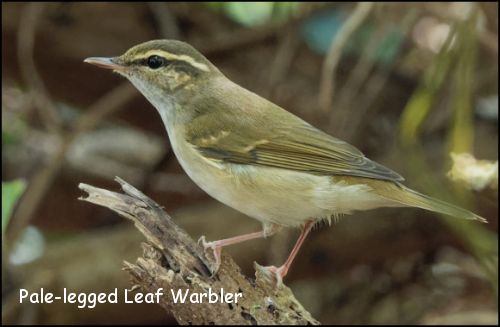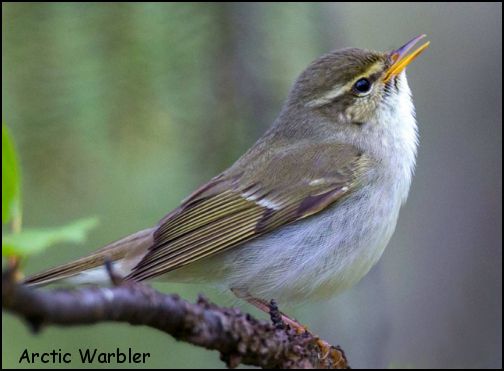A one day birdwatching trip to Spurn, October 2024 - Colin Butler
There had been a period of high pressure over Easter Europe with a low pressure over the Benelux
countries which resulted in a continued period of Easterly winds.
This meant only one thing, a trip to the East coast was called for.
These conditions had resulted in a fall of migrants recorded in East Yorkshire, the only matter to be
decided was which destination Flamborough or Spurn Point?
A record of a Pale-legged Leaf Warbler (a first live record for the Western Palearctic) had been found
at Bempton Cliffs RSPB reserve on Friday evening. Due to family matters I had not been able to go to the East coast over the week-end and the
beginning of the week, Thursday being the first day that was free.
Due to family matters I had not been able to go to the East coast over the week-end and the
beginning of the week, Thursday being the first day that was free.
On Wednesday all day and overnight there had been a continuous high pressure over the whole of
the UK, a scenario which meant that there was a likelihood that many grounded migrants would
continue their migration. This meant that a contingency plan was required.
As no one had responded to my email to accompany me I decided to leave home at 06:00, this would
result in my being at Junction 35 of the M62 at 08:00, I arrived at exactly 08:00, where I checked Bird
guides to see if the bird had been seen. As there was no notifications I re-joined the M62 an exited at
the North Cave exit where I again checked Bird guides to see the negative sighting.
I was then in a position to continue my journey along the M62 to eventually be at Spurn for 10:30.
I usually leave home at 04:00 to beat the traffic at Manchester, Leeds and Hull with a normal arrival
time of around 07:00.
I was almost hoping for the negative news as Spurn is my favourite place in the UK, the best place to
see visible migration in the UK.
I had, rather foolishly forgotten to bring along my Spurn CB radio but never the less had my phone so
I could still keep aware of the sightings at Spurn on both Twitter and Bird guides.
As I was driving through Easington is was obvious that migration was in full swing, Meadow Pipits,
Swallows and Thrushes were noted in flight and flitting about on the bushes and telegraph wires,
excitement was beginning.
My first port of call was the Crown & Anchor pub car park which is a reliable site due to the trees and
scrub which are in pub grounds.
After just a few minutes I managed to see the first passerine which was a Red-breasted Flycatcher,
which was soon followed by Chiffchaff, Willow Warbler, Blackcap and Goldcrest. I have previously
been at Spurn with literally thousand of these tiny waifs on the road, even sitting on my shoe after
their perilous journey across the North Sea.
News came in of another bird that I wished to see which was along the peninsula towards the
lighthouse. Due to the continuous storm surges the peninsula has now been completely cut off
making the journey by car impossible with the option now open to walk across the breach on the
beach which is either sand or pebble depending upon the chosen route.
After a walk of around 45 minutes I arrived at the spot, quickly seeing the Arctic Warbler briefly
before it flew along the beach and was lost to sight. I then walked back to my car noting an arrival of Redwings flying in off the North Sea with Meadow
Pipits also continuing to arrive whilst Swallows were noted flying down the peninsula.
A flock of Brent Geese were also noted with them staying for the winter months. Migration at its best
Swallows departing for Africa passerines being blown off course during their migration, Swallows
departing for Africa and Brent Geese Meadow Pipits and Thrushes arriving to overwinter, that is
Spurn. Due to the continuous storm surges the peninsula has now been completely cut off
making the journey by car impossible with the option now open to walk across the breach on the
beach which is either sand or pebble depending upon the chosen route.
After a walk of around 45 minutes I arrived at the spot, quickly seeing the Arctic Warbler briefly
before it flew along the beach and was lost to sight. I then walked back to my car noting an arrival of Redwings flying in off the North Sea with Meadow
Pipits also continuing to arrive whilst Swallows were noted flying down the peninsula.
A flock of Brent Geese were also noted with them staying for the winter months. Migration at its best
Swallows departing for Africa passerines being blown off course during their migration, Swallows
departing for Africa and Brent Geese Meadow Pipits and Thrushes arriving to overwinter, that is
Spurn.
As I walked back to my car I passed the Warren, where I used to stay a long time ago when I stayed
for a few days, it is another known location to see birds freshly arriving having crossed the North Sea
it was obvious that migration was still taking place with birds seen flying over the embankment and
diving into the low bushes. Willow Warblers and a lone Spotted Flycatcher were some of the birds
identified.
I then has a decision to make, to stay until after 5pm to miss the traffic congestion at Hull, Leeds and
Manchester or to leave earlier to pass those bottlenecks before peak time.
I had a family event which I wanted to attend so I decided that I would leave around 2pm, but the
birding had not yet finished.
I again visited the Crown & Anchor where I soon was watching a Yellow-browed Warbler flitting
about the top of the trees and a Willow Warbler imitating a flycatcher.
On my way from Easington I decided to visit Sammy’s Point which is a location, not on the North Sea
but at one of the widest spots on the mouth of the river Humber, another well-known migration spot
where I have seen many rare migrants.
It became obvious that there were few migrants here, however Swallows were noted flying in the
direction of the peninsula and Chiffchaff could be heard along with a few more Goldcrests; however
I detected a warbler out in the open sunning itself unaware of my presence. I could see that it was a
large, pale plain warbler with my thoughts immediately thinking Barred Warbler, a number of which
had been sighted, but being extremely skulking they are often never seen again. Unfortunately as
much as I tried I could not go beyond a Garden Warbler.
I then confirmed my decision to travel home, unfortunately my attempts to avoid the congestion
failed as a consequence I arrived home 3¾ hrs later, but still in time for my family event.
I future if I go for the day it will mean 04:00 start and a return of around 5pm or an overnight stay at
the observatory.
Even though my stay was an extremely brief stay and my travel time exceeded my time spent birding
it was yet another unforgettable visit to Spurn a place which I need to get regular fixes of.
Hopefully conditions will again mean that another visit to Spurn is required but normally migration
ends by the first week of November but, fingers crossed, I will manage to fit another visit this magical
place.
The birding, whilst being very good (an understatement), is extremely challenging and with the area
being large it inevitably requires long walks and a bit of driving and many of the birds skulking in the
trees and shrubs. It is however in my view the best birding to be had in the UK.
No photographs were taken as I wished to max my time viewing the birds
|
|